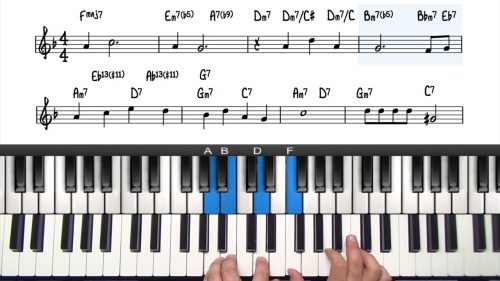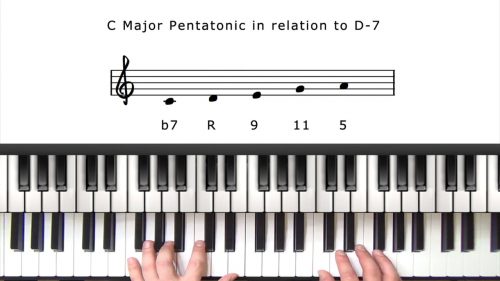Boogie-Woogie Riffs & Licks
Welcome to lesson 5 in this course on boogie-woogie piano. In the previous lessons, we have explored the history, style, basslines, voicings, rhythms, & turnarounds.
In this lesson, we will examine the right-hand riffs and licks that make the boogie-woogie style so infectious.
Boogie-Woogie Scales & Improvisation
Besides the standard major and minor scales, there are two scales that are more common to playing blues and boogie-woogie; the blues scale and the pentatonic scale.
Within a particular boogie-woogie piano piece, you will find yourself using elements from both of these scales. Although in boogie-woogie, the pentatonic scale more is more widely used.
Using The ‘Blue Note’
If we take the basic major pentatonic scale, we have the following notes of the related major scale: 1-2-3-4-5-6
We can extend this basic major pentatonic scale to include the ‘blue notes’. The blue notes are minor 3rd, and the flat 5, and this give it that kind of hard, gritty, bluesy sound.
In boogie-woogie, the blue notes in the blues scale are used, but they are used more as chromatic passing tones when moving to primary chord tones which we aim for as ‘landing points’.
The Pentatonic Scale & The I6 Chord Voicing
You will notice that the major pentatonic scale contains the primary notes of the I6 chord voicing we have explored in previous lessons. This means that many of the same principles can be applied to right-hand licks.
In particular, we can utilise the chromatic element when we move the notes up or down a half step to achieve interesting tension and release.
Licks Using 3rd & 6th Intervals
In boogie-woogie music, the RH licks are often made up of 3rds and 6ths intervals moving chromatically up or down the keyboard. This is a characteristic sound of the music and one that you will hear in countless recordings.
Boogie-Woogie Slurs & Slide-Offs
One stylistic device that gets used a lot is a quick slur through a number of notes, often outlining the shape of an arpeggio. We already explored this concept in the turnarounds examples in the previous lesson. We will now look at more specific examples and demonstrations.
The slide-off is a similar concept to the slur, and the demonstrations in this lesson will help you to understand this concept and its use in boogie-woogie music.
Boogie-Woogie Trills
Trills get used all over the place in boogie-woogie music. They can be used in intros like in the intro to Pinetop’s Boogie Woogie. They also get used very often within the verses, like in the verse from The “Boogie-Woogie Prayer” that will will arrange later in this course.
Lesson Downloads
-
Boogie Woogie Riffs & Licks File Type: pdf
Practice Tips
-
Slurs, trills, and slide-offs are 3 of the essential right-hand ingredients to create the feel of the boogie-woogie style.
-
Once you have a sense to the sound of it, learn by age-old practice of 'stealing licks'.
-
This is not 'stealing' in the literal sense, instead, we are referring to listening to boogie-woogie records, and learning the licks by ear.
-
Most modern online video players will give you the option to slow down the performance or recording which is useful to transcribe the notes by ear.
-
You can also use transcription software to slow down and loop a particular section of a recording.
-
For any boogie-woogie standard that you learn, you can use those licks in other contexts. So everything is transferable to other tunes you are playing.
-
Improvisation is like 'telling a story'. The various licks are like words, phrases, and ideas, which you can use to 'tell your story'.








Só cool!I m already grooving thr boggie woogie baby ;).Thks for the teachings
Awesome thanks so much for your great lessons
Dear Jovino and Hayden, Great lessons!!. However, I am struggling to develop hand independence and have reached a point of frustration as I am not seeing much progress. Kindly guide.
regards,
One more point, in the Boogie-Woogie lesson videos, we dont have the provision to slow the speed up. Pls advise.
Hi Shantanu,
Apologies for this.
I have added the speed button option.
It is in the bottom right hand side of the video container.
Any further problems let me know.
Cheers,
Hayden
Hi Shantanu,
We have an upcoming course on “Chicago Blues” style which is a slower version of Boogie Woogie.
The course will be published in the next 2 or 3 weeks.
We give specific guidance for hand independence and we cover a number of simple left hand patterns which are useful to develop hand independence whilst playing the blues.
More to be announced shortly.
Cheers!
Hayden
Thanks a ton Hayden